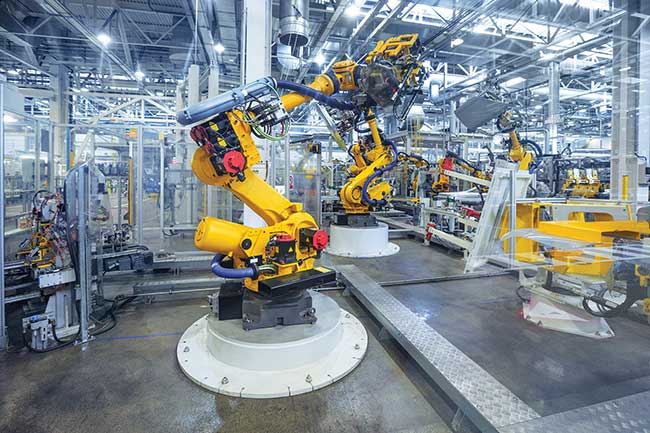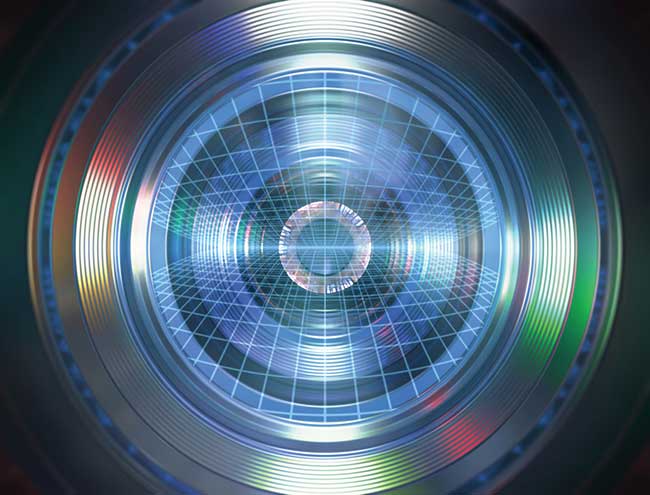JOHANNES HILTNER, MVTEC SOFTWARE GMBH
Machine vision solutions can be used for a wide range of tasks, such as defect inspections, positioning, handling workpieces, and recognizing and identifying objects. One challenge is to pick a software system that best fits requirements and can be a tool for upcoming tasks. Following a few straightforward criteria can help.
Seek robust features on embedded systems. Today’s machine vision software must support fully integrated and highly automated production processes, for example, in the industrial Internet of Things (iIoT). Throughout the value chain, all means of production — human workers, collaborative robots (cobots), machines, sensors, transfer systems, and smart devices — need to work together seamlessly, integrated via the company network or the internet. Machine vision software has to keep up with all related requirements.

Machine vision software must support fully integrated and highly automated production processes. Courtesy of MVTec.
The software should run on various compact embedded devices, such as mobile smart cameras or smart sensors, that are typically used in iIoT environments. These kinds of sensors are becoming smarter and smaller.
Many use ARM processors. By default, state-of-the-art machine vision software should support embedded platforms that are based on this widely distributed and popular processing architecture. This would allow seamless use of the accustomed robust functions of standard machine vision software in the diverse landscape of embedded systems. For example, with optical character recognition techniques, the right software will allow number and letter combinations to be read with mobile hand-held devices to reliably identify objects, even if the characters are hard to read, distorted, or blurry.
Machine vision solutions can be used for a wide range of tasks. One challenge is to pick a software system that best fits requirements and can be a tool for upcoming tasks.
Embrace deep learning technologies. The right choice of machine vision software also should support new technologies based on artificial intelligence. Methods such as machine learning, deep learning, and convolutional neural networks (CNN) help make identification processes more precise and allow adaptation to the requirements of modern automation. These methods have been designed to comprehensively analyze and evaluate large amounts of data (big data) to train many different object and defect classes.
Companies often shy away from employing deep learning technologies. Training generally requires a large amount of sample images to identify objects accurately. Up to 100,000 comparison images are needed for each class that needs to be reviewed to achieve adequate recognition rates. Even when the necessary sample data is available, training takes an enormous amount of time. Usually, the programming work for identifying different defect classes during error inspection is also extremely complex. This typically requires highly skilled employees with extensive expertise.

As the eye of production, machine vision solutions can be used for a wide range of tasks, such as defect inspections, positioning, handling workpieces, and recognizing and identifying objects. Courtesy of Fotolia.
To get around this expensive and time-consuming requirement, look for machine vision software that provides a set of deep learning features that can be easily used out of the box. The ideal software should enable a company to train CNNs themselves without a great deal of time and money.
One feature to look for is a system with CNNs that are pretrained for industrial applications by being optimized for speed and maximum recognition rates. This shortens the training process and the amount of programming work by requiring only a few sample images.
Nevertheless, it still yields a neural network that can be precisely matched to a specific requirement.
Pretrained CNNs should come with a large stack of royalty-free images from different industrial environments. This means that the applications using these networks are free from third-party copyrights.
Default should support merging technologies. To enable integrated manufacturing processes, different system environments must interact and communicate seamlessly with each other. Modern machine vision software, for example, has to provide sophisticated features that are able to work closely with a programmable logic controller. Consistent standards and interfaces are available for merging both technologies.
The open platform communications unified architecture (OPC UA) plays one of the most important roles in this regard. As a modern machine-to-machine communication protocol, OPC UA makes it easy to exchange information between the components of several technology providers. It also works within heterogeneous infrastructures consisting of different hardware modules. In this way, semantic interoperability for communication with the overall system becomes reality. Consequently, the ideal machine vision software should also support OPC UA by default.
MVTec’s HALCON software was specifically designed to meet the critical criteria for modern machine vision software. It supports embedded sensors and systems that use ARM processors and allows customers to use the robust functions of their standard system. As an out-of-the-box solution, the software comes equipped with a stack of around three million royalty-free images from industrial environments. HALCON also supports OPC UA by default.
Meet the author
Johannes Hiltner is a product manager responsible for the HALCON software at MVTec Software GmbH. He joined the company in 2008, starting as an application engineer, and has held his current position since 2015. He has a degree in electrical engineering from the Technical University of Munich; email: [email protected].